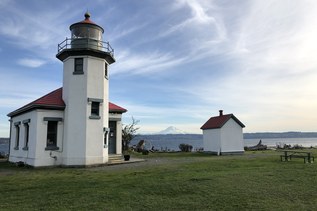From the parking area at the end of Edwards Way, trails head both east and west along the shore. The two routes are rather different, but complementary. You can explore them in either order. Some hikers prefer to do the east-bound segment first, as described here, but it's up to you.
Head east on the obvious trail. Clouds permitting enjoy good views out toward Guemes, Cypress and Lummi Islands, with parts of more distant islands visible. The east-bound trail itself is wide and paved for its entire length, about 1.1 miles each way as of spring 2019. Some hiking books list a shorter mileage, perhaps from a time when the trail extended less far.
The seaward edge of the trail may show signs of wave erosion. In 2019, orange traffic cones marked the most damaged areas, although the erosion was not enough to have any impact on trail use by hikers. The situation could evolve by the time you do your hike.
The beach along this part of the hike is very stony and not at all inviting for exploration. More rocks are exposed at low tide, and you are likely to see herons and gulls foraging here.
Also, be alert for other birds aloft. It's not unusual to see an eagle coast by just a few feet overhead, or another one circling at higher altitude. Ospreys too may be seen here, and many sea-birds.
The steep landward side of the trail is very green, almost like a jungle in places, and here and there large trees lean in over the trail. On this forested slope next to the trail be alert for robins and a variety of small birds.
In spring, you may find a few wildflowers blooming on these north-facing slopes, some of them the same ones you would see along trails in the Anacortes Community Forest Lands, such as avens, creeping raspberry, thimbleberry, salmonberry, youth-on-age, fringecup, miner's lettuce, buttercups, Nootka rose, and bright orange impatiens.
Along the way, you will note a few pathways heading steeply uphill, some gated and leading to private residences. One or two of these paths do appear to lead up to neighborhood streets, but please respect the neighbors privacy.
One side trail is worth exploring: about a quarter mile before the eastern end of the main trail an impressive wooden staircase heads uphill. A sign indicates it leads to Roadside Park, the actual name of a small, nondescript park along the Highway 20 Spur, opposite Kansas Ave.
The park itself isn't much, but the stair route — which also has some earthen trail — is quite interesting, passing through woods with views back down to the beach. The uppermost flight of stairs passes over what must once have been an old dump, with bits of antique glass and old metal showing on the surface. This optional side trip will add about 0.15 miles to your round trip mileage, with about 100 feet of elevation gain. When you have looked around the park, return back down the stairs to the main trail.
The main trail itself comes to an abrupt, gated end at a private property boundary. There is a good side view of what little remains of the schooner Merced (Spanish for "Mercy,") now a breakwater filled with gravel and planted with trees. A sign posted on the gate offers some history.
Return to the parking area. Then begin the westbound part of your hike. It's about a half mile each way, and is very different from the eastbound segment. It offers a gentle meander through low shrubbery, much of it Nootka rose, whose blooms in spring are quite fragrant. Small trailside posts offer information about local flora and fauna.
Occasional openings on the right offer access to the beach that is sandy here, in contrast to what you saw along the eastbound trail. Other viewpoints overlooking the beach offer benches and signs with historical displays. The last part of the trail is on sturdy boardwalk.
At one point, the trail splits briefly. It's a loop so you can go either way. The final ongoing section of trail is next to a cattail marsh, a seasonal home for red-wing blackbirds whose distinct calls will be evident. Some yellow irises bloom here too.
The trail ends at a viewpoint perhaps 600 feet short of the ferry terminal. Many old pilings visible in the shallows here once supported fish canneries, now long gone.
At low tide the beach is easily walkable and you will have the option of continuing on to the terminal for a break. Also, ferry passengers parked in the queue for a later sailing can meander down to the beach and, time permitting, enjoy hiking part of the western end of the trail.






 Trailhead
Trailhead


